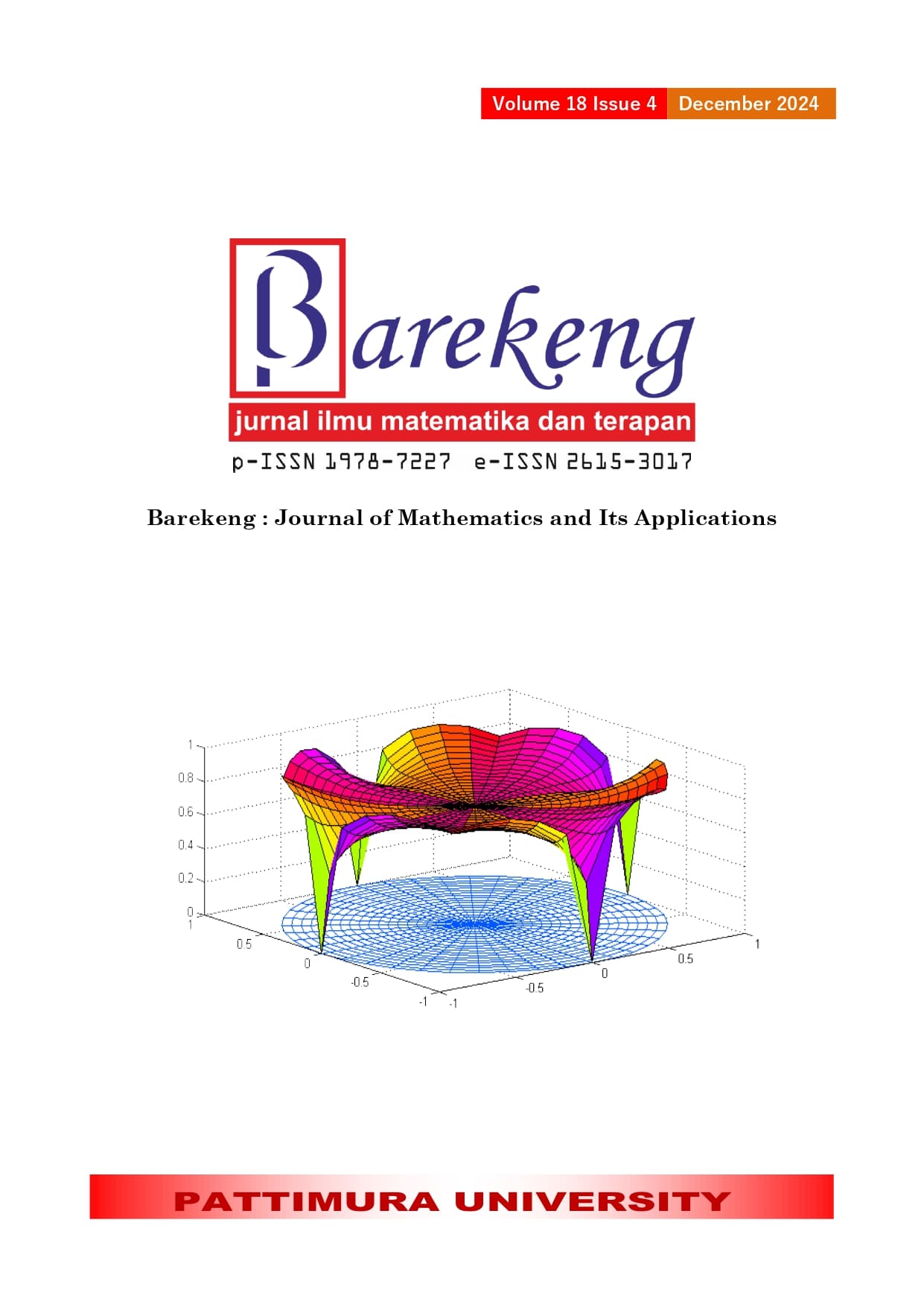S-BOX CONSTRUCTION IN THE ADVANCED ENCRYPTION STANDARD (AES) DEVELOPMENT ALGORITHM IN GF(2^2), GF(2^4) & GF(2^6)
Abstract
This research aims to obtain a method for constructing S-boxes based on GF(22), GF(24) and GF(26). A review of the Galois Field GF(2m) is presented for m=1,2,3,4,5 and 6. Furthermore, it is used to construct an S-box based on GF(22), GF(24) and GF(26). Based on these results, later it can be developed for S-box construction in the AES algorithm which uses the Galois Field GF(2m) for m>=10.
Downloads
References
A. Aidoo and K. B. Gyam, “Construction of Irreducible Polynomials in Galois fields, GF(2m) Using Normal Bases,” Asian Res. J. Math., vol. 14, no. 3, pp. 1–15, Jul. 2019, doi: 10.9734/arjom/2019/v14i330131.
A. Chandoul and A. M. Sibih, “Note on irreducible polynomials over finite field,” Eur. J. Pure Appl. Math., vol. 14, no. 1, pp. 265–267, 2021, doi: 10.29020/NYBG.EJPAM.V14I1.3898.
B. Nithya and V. Ramadoss, “Extension fields and Galois Theory,” Int. J. Math. Trends Technol., vol. 65, no. 7, 2019, doi: 10.14445/22315373/ijmtt-v65i7p507.
S. Dey and R. Ghosh, “Mathematical Method to Search for Monic Irreducible Polynomials with Decimal Equivalents of Polynomials over Galois Field GF(pq),” Circ. Comput. Sci., vol. 2, no. 11, 2017, doi: 10.22632/ccs-2017-252-68.
R. H. Prayitno, S. A. Sudiro, S. Madenda, and S. Harmanto, “HARDWARE IMPLEMENTATION OF GALOIS FIELD MULTIPLICATION FOR MIXCOLUMN AND INVERSEMIXCOLUMN PROCESS IN ENCRYPTION-DECRYPTION ALGORITHMS,” J. Theor. Appl. Inf. Technol., vol. 100, no. 14, 2022.
A. Nakashima, R. Ueno, and N. Homma, “AES S-Box Hardware With Efficiency Improvement Based on Linear Mapping Optimization,” IEEE Trans. Circuits Syst. II Express Briefs, vol. 69, no. 10, 2022, doi: 10.1109/TCSII.2022.3185632.
H. H. Mahmoud and M. M. Hoobi, “Improved Rijndael by encryption S-Box Using NTRU Algorithm,” Iraqi J. Sci., vol. 56, no. 4, pp. 2984–2995, 2015.
N. Angraini and Y. Suryanto, “MODIFICATION ADVANCED ENCRYPTION STANDARD (AES) ALGORITHM WITH PERFECT STRICT AVALANCHE CRITERION S-BOX,” J. Tek. Inform., vol. 3, no. 4, 2022, doi: 10.20884/1.jutif.2022.3.4.352.
K. Zhao, Ring and Field Theory. 2022. doi: 10.1142/12819.
J. Stillwell, Undergraduate Analysis (Undergraduate Texts in Mathematics). 1996.
R. Lidl and H. Niederreiter, Introduction to Finite Fields and their Applications. 1994. doi: 10.1017/cbo9781139172769.
D. Hachenberger and D. Jungnickel, Topics in Galois Fields, vol. 29. 2020. [Online]. Available: http://link.springer.com/10.1007/978-3-030-60806-4
S. Chibeti, I. Kyapwanyama, H. M. Phiri, and J. Kalunga, “An Introduction to the Theory of Field Extensions,” Adv. Pure Math., vol. 13, no. 02, pp. 103–132, 2023, doi: 10.4236/apm.2023.132006.
L. Childs, A Concrete Introduction to Higher Algebra. 1996. [Online]. Available: http://www.amazon.com/Undergraduate-Analysis-Texts-Mathematics/dp/0387948414
Alamsyah, B. Prasetyo, and Y. Muhammad, “S-box Construction on AES Algorithm using Affine Matrix Modification to Improve Image Encryption Security,” Sci. J. Informatics, vol. 10, no. 2, 2023, doi: 10.15294/sji.v10i2.42305.
H. Susanto, Alamsyah, and A. T. Putra, “Security Improvement of the 256-BIT AES Algorithm With Dynamic S-Box Based on Static Parameter as the Key for S-Box Formation,” J. Adv. Inf. Syst. Technol., vol. 4, no. 1, pp. 33–41, 2022, doi: 10.15294/jaist.v4i1.59976.
W. E. Ahmed, “A Modern Method for Constructing the S-Box of Advanced Encryption Standard,” Appl. Math., vol. 10, no. 04, pp. 234–244, 2019, doi: 10.4236/am.2019.104018.
J. K. Kim, “On the Modification of Finite Field Based S-Box,” East Asian Math. J., vol. 37, no. 1, pp. 1–7, 2021.
N. Siddiqui et al., “A Highly Nonlinear Substitution-Box (S-Box) Design Using Action of Modular Group on a Projective Line Over a Finite Field,” PLoS One, vol. 15, no. 11 November, pp. 1–16, 2020, doi: 10.1371/journal.pone.0241890.
F. Tita, A. Setiawan, and B. Susanto, “Performance of S-Box Constructed by Irreducible Polynomials on GF(2),” 2024 IEEE Symp. Ind. Electron. Appl., 2024.
Copyright (c) 2024 Adi Setiawan, Faldy Tita, Bambang Susanto

This work is licensed under a Creative Commons Attribution-ShareAlike 4.0 International License.
Authors who publish with this Journal agree to the following terms:
- Author retain copyright and grant the journal right of first publication with the work simultaneously licensed under a creative commons attribution license that allow others to share the work within an acknowledgement of the work’s authorship and initial publication of this journal.
- Authors are able to enter into separate, additional contractual arrangement for the non-exclusive distribution of the journal’s published version of the work (e.g. acknowledgement of its initial publication in this journal).
- Authors are permitted and encouraged to post their work online (e.g. in institutional repositories or on their websites) prior to and during the submission process, as it can lead to productive exchanges, as well as earlier and greater citation of published works.






1.gif)



